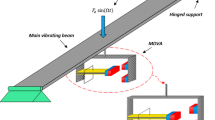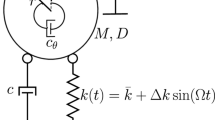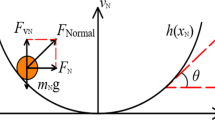Abstract
We study the critical transition problem for a stochastically forced birhythmic vibro-impact (BVI) model with improved memory damping regime (IMDR) effect. This paper then reports a detailed probabilistic description on the random distribution of the oscillator response. Analytical criteria for critical transitions are obtained successively relying on the amplitude probability, the most probable amplitude (MPA), the joint probability, its cross-sectional view, and the contour projection, which can complement each other. Besides, numerical simulations are carried out to check the theoretical evaluation results. Detect the control parameter source inducing the transition between monorhythmicity and birhythmicity, also indicating the tipping interval of stochastic P-bifurcation and the critical evolution of the half-shaped stochastic attractor mode determined by the vibro-impact constraint, which can also be visually displayed by the intermittent behavior of time history responses. The alternation of feedback gains design of IMDR can subvert the utility direction of transitions caused by some control parameters. Shannon entropy measure is added to display a quantitative indication of the reference interval for the parameters triggering bifurcations, so as to lock effectively in the rhythm mode required by engineering application issues.



















Similar content being viewed by others
Data availability
The datasets generated and/or analyzed during the current study are available from the corresponding author upon request.
References
Ramos, J., Kim, S.: Dynamic locomotion synchronization of bipedal robot and human operator via bilateral feedback teleoperation. Sci. Robotics 4(35), eaav4282 (2019)
Zhang, C.L., Lai, Z.H., Li, M.Q., D,: Yurchenko, Wind energy harvesting from a conventional turbine structure with an embedded vibro-impact dielectric elastomer generator. J. Sound Vib. 487, 115616 (2020)
Chen, H., Kurt, M., Lee, Y.S., McFarland, D.M., Bergman, L.A., Vakakis, A.F.: Experimental system identification of the dynamics of a vibro-impact beam with a view towards structural health monitoring and damage detection. Mech. Syst. Signal Process. 46(1), 91–113 (2014)
Dimentberg, M.F., Iourtchenko, D.V.: Random Vibrations with Impacts: A Review. Nonlinear Dyn. 36(2–4), 229–254 (2004)
Shi, J.Y., Bamer, F., Markert, B.: A structural pounding formulation using systematic modal truncation. Shock Vib. 2018, 1–15 (2018)
Cai, W., Zhu, L., Yu, T.X., Li, Y.G.: Numerical simulations for plates under ice impact based on a concrete constitutive ice model. Int. J. Impact Eng. 143, 103594 (2020)
Kozlov, V.V., Kozlov, V.V., Treshchev, D.V., Treshchëv, D.V.: Billiards: A Genetic Introduction to the Dynamics of Systems with Impacts: A Genetic Introduction to the Dynamics of Systems with Impacts. American Mathematical Soc., Providence, Rhode Island (1991)
Babitsky, V.I.: Theory of vibro-impact systems and applications. Springer Science & Business Media, Germany (2013)
Huang, Z.L., Liu, Z.H., Zhu, W.Q.: Stationary response of multi-degree-of-freedom vibro-impact systems under white noise excitations. J. Sound Vib. 275(1–2), 223–240 (2004)
Wu, Y., Zhu, W.Q.: Stationary response of multi-degree-of-freedom vibro-impact systems to Poisson white noises. Phys. Lett. A 372(5), 623–630 (2008)
Xu, W., Feng, J.Q., Rong, H.W.: Melnikov’s method for a general nonlinear vibro-impact oscillator. Nonlinear Anal. Theory Methods Appl. 71(1–2), 418–426 (2009)
Xu, M., Wang, Y., Jin, X.L., Huang, Z.L., Yu, T.X.: Random response of vibro-impact systems with inelastic contact. Int. J. Non-Linear Mech. 52, 26–31 (2013)
Zhu, H.T.: Probabilistic solution of vibro-impact stochastic Duffing systems with a unilateral non-zero offset barrier. Physica A 410, 335–344 (2014)
Kumar, P., Narayanan, S., Gupta, S.: Bifurcation analysis of a stochastically excited vibro-impact Duffing-Van der Pol oscillator with bilateral rigid barriers. Int. J. Mech. Sci. 127, 103–117 (2017)
Ren, Z.C., Xu, W., Wang, D.L.: Dynamic and first passage analysis of ship roll motion with inelastic impacts via path integration method. Nonlinear Dyn. 97(1), 391–402 (2019)
Wang, D.L., Xu, W., Gu, X.D.: Stationary response of stochastic viscoelastic system with the right unilateral nonzero offset barrier impacts. Chinese Phys. B 28(1), 010203 (2019)
Qian, J.M., Chen, L.C.: Random vibration of SDOF vibro-impact oscillators with restitution factor related to velocity under wide-band noise excitations. Mech. Syst. Signal Proc. 147, 107082 (2021)
Wang, L., Peng, J.H., Wang, B.C., Xu, W.: The response of stochastic vibro-impact system calculated by a new path integration algorithm. Nonlinear Dyn. 104(1), 289–296 (2021)
Wang, D.L., Xu, W., Ren, Z.C., Pei, H.Q.: Maximal lyapunov exponents and steady-state moments of a VI system based upon TDFC and VED. Int. J. Bifurcation Chaos 29(11), 1950155 (2019)
Decroly, O., Goldbeter, A.: Birhythmicity, chaos, and other patterns of temporal self-organization in a multiply regulated biochemical system. Proc. Natl. Acad. Sci. 79(22), 6917–6921 (1982)
Kar, S., Ray, D.S.: Large fluctuations and nonlinear dynamics of birhythmicity. EPL (Europhy. Lett.) 67(1), 137 (2004)
Biswas, D., Banerjee, T., Kurths, J.: Control of birhythmicity: A self-feedback approach. Chaos: An Interdiscip. J. Nonlinear Sci. 27(6), 063110 (2017)
Ghosh, P., Sen, S., Riaz, S.S., Ray, D.S.: Controlling birhythmicity in a self-sustained oscillator by time-delayed feedback. Phys. Rev. E 83(3), 036205 (2011)
Bashkirtseva, I., Ryashko, L.: Sensitivity analysis of stochastic attractors and noise-induced transitions for population model with Allee effect. Chaos: An Interdiscip. J. Nonlinear Sci. 21(4), 047514 (2011)
Kwuimy, C.A.K., Nataraj, C.: Recurrence and joint recurrence analysis of multiple attractors energy harvesting system Structural nonlinear dynamics and diagnosis, pp. 97–123. Springer, Cham (2015)
Yamapi, R., Filatrella, G.: Noise effects on a birhythmic Josephson junction coupled to a resonator. Phys. Rev. E 89(5), 052905 (2014)
Guo, Q., Sun, Z.K., Xu, W.: Bifurcations in a fractional birhythmic biological system with time delay. Commun. Nonlinear Sci. Numer. Simul. 72, 318–328 (2019)
Sun, Y.L., Ning, L.J.: Bifurcation Analysis of a Self-Sustained Birhythmic Oscillator Under Two Delays and Colored Noises. Int. J. Bifurcation Chaos 30(01), 2050013 (2020)
de Espíndola, J.J., Bavastri, C.A., Lopes, E.M.O.: On the passive control of vibrations with viscoelastic dynamic absorbers of ordinary and pendulum types. J. Franklin Inst. 347(1), 102–115 (2010)
Wang, R., Shang, J.Z., Li, X., Luo, Z.R., Wu, W.: Vibration and damping characteristics of 3D printed Kagome lattice with viscoelastic material filling. Sci. Rep. 8(1), 1–13 (2018)
Tuan, L.A., Lee, S.-G., Nho, L.C., Cuong, H.M.: Robust controls for ship-mounted container cranes with viscoelastic foundation and flexible hoisting cable. Proc. Inst. Mech. Eng., Part I: J. Syst. Control Eng. 229(7), 662–674 (2015)
Charrier, E.E., Pogoda, K., Wells, R.G., Janmey, P.A.: Control of cell morphology and differentiation by substrates with independently tunable elasticity and viscous dissipation. Nat. Commun. 9(1), 1–13 (2018)
Christensen, R.: Theory of viscoelasticity: an introduction. Elsevier, Amsterdam (2012)
Drozdov, A.D.: Viscoelastic structures: mechanics of growth and aging. Academic Press, Cambridge (1998)
Zhu, W.Q., Cai, G.Q.: Random vibration of viscoelastic system under broad-band excitations. Int. J. Non-Linear Mech. 46(5), 720–726 (2011)
Karimi, M.M., Tabatabaee, N., Jahangiri, B., Darabi, M.K.: Constitutive modeling of hardening-relaxation response of asphalt concrete in cyclic compressive loading. Constr. Build. Mater. 137, 169–184 (2017)
Narimissa, E., Wagner, M.H.: Modeling nonlinear rheology of unentangled polymer melts based on a single integral constitutive equation. J. Rheol. 64(1), 129–140 (2020)
Arnold, L.: Random dynamical systems. Springer, New York (1998)
Ashwin, P., Wieczorek, S., Vitolo, R., Cox, P.: Tipping points in open systems: bifurcation, noise-induced and rate-dependent examples in the climate system. Phil. Trans. Royal Soc. A: Math., Phys. Eng. Sci. 370(1962), 1166–1184 (2012)
Ashwin, P., Perryman, C., Wieczorek, S.: Parameter shifts for nonautonomous systems in low dimension: bifurcation-and rate-induced tipping. Nonlinearity 30(6), 2185 (2017)
Kaiser, F., Eichwald, C.: Bifurcation structure of a driven, multi-limit-cycle van der pol oscillator (i): The superharmonic resonance structure. Int. J. Bifurcation Chaos 1(02), 485–491 (1991)
Eichwald, C., Kaiser, F.: Bifurcation structure of a driven multi-limit-cycle van der Pol oscillator (ii): Symmetry-breaking crisis and intermittency. Int. J. Bifurcation Chaos 1(03), 711–715 (1991)
Kadji, H.G.E., Orou, J.B.C., Yamapi, R., Woafo, P.: Nonlinear dynamics and strange attractors in the biological system. Chaos, Solitons Fractals 32(2), 862–882 (2007)
Zhuravlev, V.F.: A method for analyzing vibration-impact systems by means of special functions. Mech. Solids 11(2), 23–27 (1976)
Zhu, W.Q.: Random vibration [M]. Science Press, Beijing (1992).. (in Chinese)
Roberts, J., Spanos, P.: Stochastic averaging: an approximate method of solving random vibration problems. Int. J. Non-Linear Mech. 21, 111–134 (1986)
Liu, Z.H., Zhu, W.Q.: Stochastic averaging of quasi-integrable Hamiltonian systems with delayed feedback control. J. Sound Vib. 299(1–2), 178–195 (2007)
Gaudreault, M., Drolet, F., Viñals, J.: Analytical determination of the bifurcation thresholds in stochastic differential equations with delayed feedback. Phys. Rev. E 82(5), 051124 (2010)
Phillis, Y.A.: Entropy stability of continuous dynamic systems. Int. J. Control 35(2), 323–340 (1982)
Kumar, P., Narayanan, S., Gupta, S.: Investigations on the bifurcation of a noisy Duffing–van der Pol oscillator. Probab. Eng. Mech. 45, 70–86 (2016)
Venkatramani, J., Sarkar, S., Gupta, S.: Intermittency in pitch-plunge aeroelastic systems explained through stochastic bifurcations. Nonlinear Dyn. 92(3), 1225–1241 (2018)
Acknowledgements
This work was supported by the National Natural Science Foundation of China (12002250), China Postdoctoral Science Foundation (2020M683429), and the Natural Science Foundation of Shaanxi Province (2021JM-349).
Funding
National Natural Science Foundation of China, 12002250, Deli Wang, Postdoctoral Research Foundation of China, 2020M683429, Deli Wang, Natural Science Foundation of Shaanxi Province, 2021JM-349.
Author information
Authors and Affiliations
Corresponding authors
Ethics declarations
Conflict of interest
The authors declare that they have no conflict of interest.
Additional information
Publisher's Note
Springer Nature remains neutral with regard to jurisdictional claims in published maps and institutional affiliations.
Rights and permissions
About this article
Cite this article
Wang, D., Pei, H., Xu, W. et al. Transitions in a noisy birhythmic vibro-impact oscillator with improved memory damping regime. Nonlinear Dyn 108, 1045–1070 (2022). https://doi.org/10.1007/s11071-022-07261-5
Received:
Accepted:
Published:
Issue Date:
DOI: https://doi.org/10.1007/s11071-022-07261-5




